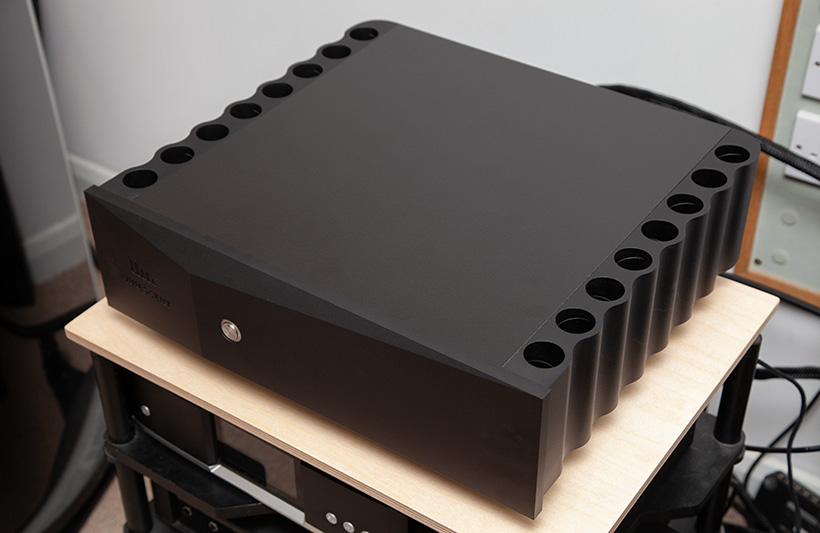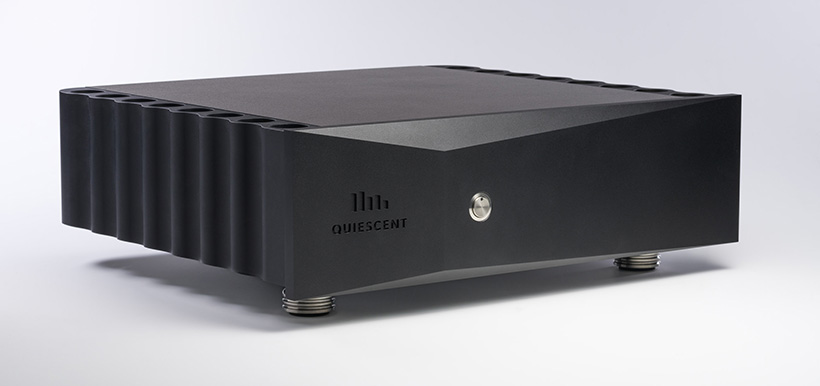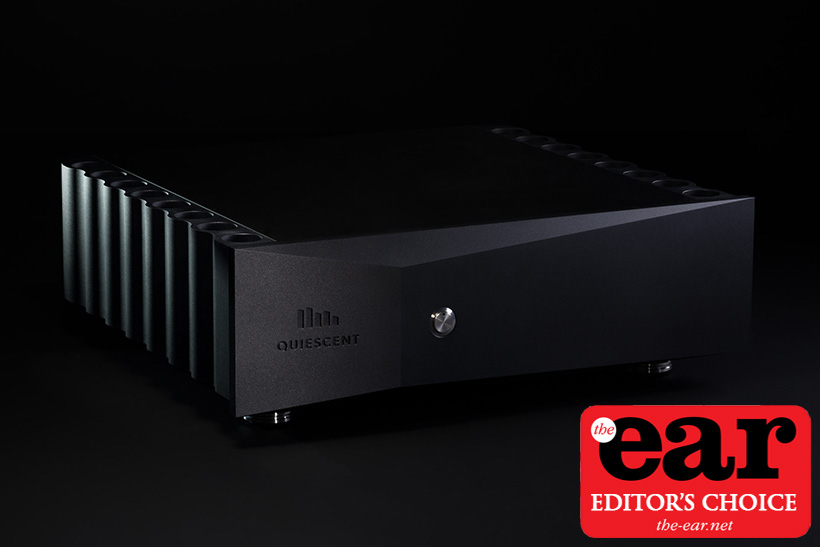Quiescent T100SPA stereo power amplifier
Kevin Fiske reviewed a balanced mains supply from Quiescent recently and that piqued our interest in a relatively new British brand that’s turning out some extremely well made products. It turns out that the name is a lot newer than the company behind it which started out as VertexAQ in 2001, so we had to wonder, why the change? You only have to look at the products produced by these two brands to see the answer, Quiescent products make those from VertexAQ look crude by comparison, and this sophistication is not skin deep.
The casework on the T100SPA, Quiescent’s stereo power amplifier, is absolutely first class and in the same league as that found on amplifiers at considerably higher prices. It warrants comparison with dCS, MSB and Constellation in terms of precision and attention to detail, yet, unlike those sexy beasts, the form is as functional as it is attractive. Look closely and you can see that each of the tubular holes in the heatsink has a distinct helix carved into its surface, get down lower and it’s clear that the bottom of this section is angled up to avoid parallel surfaces at either end. Both these techniques are designed to reduce resonance in the casework. Quiescent also use a non metallic material in the case, the top cover is in Trespa, a high pressure laminate made of phenolic resin and wood fibres. Phenolic is also used by Rega for the braces on its higher end turntables, it’s clearly an interesting material.

The Quiescent anti noise policy
If Quiescent are about anything beyond maximum high fidelity it’s the elimination of noise. They have come to the conclusion that noise is what stops audio components delivering maximum resolution, and if what we have learned from network streaming is anything to go by they are bang on the money. We are talking about low level noise of course, not any form of hum or buzz that’s audible but rather the noise floor. Signals that are quieter than the noise floor are masked by it, and these quiet sounds are what deliver a sense of transparency, giving the notion that you are hearing everything there is on the recording.
Inside the T100SPA are six black boxes surrounding an unusually large 500VA transformer with an absorption matrix provided to minimise vibration. One box contains Audio Note (UK) Kaisei capacitors which are based upon the well-respected Rubycon Black Gate versions. The remaining five boxes contain DC blocking devices, two stacked rectifier bridges with anti-vibration measures and separate anti-reflection devices to reduce high frequency noise. Great effort has gone into minimising vibration by decoupling in order to reduce microphony, something that many suppose doesn’t affect solid state circuits, but the sensitivity of amplifiers to isolation devices suggests otherwise.

About all that is revealed inside the case is the single pair of MOSFET output transistors per channel, these are rated to produce up to 130 Watts. Which is a modest rating for a 27kg amplifier but as ever power is no indication of quality, or for that matter speaker driving ability. The back of the amplifier features high quality WBT Next-gen in- and outputs, the former via RCA and XLR, the speaker connections being five-way binding posts. There is one more RCA socket marked ground and designed for Quiescent’s grounding devices, presumably however it could be used with those from other brands. There are also two switches, one for selecting between balanced and single ended inputs, the other to turn off the LED. Given that there is only one small LED on the power button this is surprising, what’s more surprising is the clear benefit that comes when you turn it off. I guess when you go to these sort of lengths to eliminate noise any source of it is going to be more obvious.
Quiescent T100SPA sound quality
All the effort that is put into keeping noise at bay is immediately obvious when the T100SPA is in the system. This is the quietest power amplifier I have had the pleasure of using, as soon as you put a decent recording on you can hear so much of the low level details that it’s uncanny. It brings a sense of calm and ease to everything it amplifies, in fact it makes most amplifiers seem like they are in a hurry, desperate to get through each track. Here you can savour every note in what appears to be its full glory. Initially I paired the Quiescent with Vivid Kaya S12 speakers which are likewise extremely quiet and transparent, the combination was totally enthralling, it felt like you could carry on turning up the volume forever without any sense of loudness or distortion getting in the way.

Given that this pairing followed the remarkable Kii Three BXT into the system I was braced for a bit of a downgrade, and while the compact Vivids don’t have the firepower of that active digital system they make up for it with an ease and musicality that is beguiling. I love the way this pairing opens up Love the One You’re With (Crosby, Stills and Nash) and brings out so much depth and dimensionality, it can’t untangle the dense mix but the music makes sense, it flows beautifully. More up to date releases deliver more in the way of layers of sound, Terry Callier’s Timepeace has arguably too much bass on the track Lazarus Man but here it remains under control and musical, the headroom from the Quiescent seems endless. And that’s compared to amplifiers with higher specified power. The key is in the low noise, this gives wider dynamic range and this combined with the relaxed delivery makes it feel as if there is more power on tap.
Timing is another key quality that’s enhanced by the ultra low noise floor of the Quiescent T100SPA, the cues that indicate tempo are not always strong, in more subtle pieces they can be less obvious and not all amplifiers pick up on this. Here, to paraphrase Yello the rhythm is divine, especially with the laid back groove of Mop Mop’s Spaceship: Earth, where the rounded bass line bounces along and the tonal richness of the band is delivered in full effect. The more familiar the piece that’s played the more obvious it is that the Quiescent is revealing details that rarely get an airing. The reverb on the small cymbal in Laurie Anderson’s Gravity’s Angel being a good example. I’ve played this on many different systems over the last few years but none have shown this much of what’s going on in the musical shadows.

Quiescent T100SPA with PMC speakers
With PMC twenty5.26i floorstanders you get slightly sharper leading edges and greater bass extension, image scale is also enhanced and with the right recording image depth as well. This works with in-the-box effects as well as genuine reverb such as can be heard on High and Dry by Stephen Stills with Manassas. Cream’s version of the blues track Rollin’ and Tumblin’ was used on the BBC’s SAS: Rogue Soldiers series (recommended by the way). I found a few versions on Qobuz with Muddy Waters’ take at Montreaux in 1972 sounding the best, but it doesn’t have the energy of Cream’s slightly raucous sixties version. All sounded great in their own way on the Quiescent/PMC pairing with Jeff Beck’s (on You Had it Coming) warranting a special mention.
Regardless of what’s played this amplifier, used with the Townshend Allegri Reference preamplifier, has genuine authority yet imparts no sense of its own character on the music. It doesn’t have that grippy sound that many high power amps do, something that comes down to a graininess that can sound good on some material but makes itself heard with acoustic recordings. The Quiescent T100SPA has a calm beneficence that allows the full gamut of expression, from nuanced to nasty, it’s transparent without having any apparent tonal emphasis. Valve amps, the good ones, can be very revealing through the mid and beyond but making them as quiet as this is nigh on impossible, and it’s the noise floor that gets in the way.

The final speaker lined up for the Quiescent to wrangle was Bowers and Wilkins’ 802 D3s, these are not an easy load and require decent current delivery to remain controlled. This proved to be well within the T100SPA’s remit, the speaker’s low colouration and high resolution making it explicit that this is a super silent amplifier that delivers its power with an ease that will have the most restrained listeners pushing up the volume.
Quiescent T100SPA power amplifier conclusion
I have been very impressed by the Quiescent T100SPA, the results it delivers and the quality of build and finish fully accord with its price point. This is a genuine high end amplifier, one that can be put up against competition approaching double its price and expect to come out on top. It’s inspiring to see the small band of British high end manufacturers expand its ranks in this way, anyone looking for electronics that will take their listening pleasure to the highest ground should try to hear a Quiescent amplifier at their earliest opportunity.
Kevin Fiske’s thoughts on the Quiescent T100SPA
Jason’s take on the Quiescent T100SPA had me nodding with recognition. The brand new T100SPA that I was loaned by Quiescent took a week or so to stabilise sonically, but once it had I heard what the Editor heard. The T100SPA does desirable things that very few other amplifiers do either to the same degree or even at all. Jason says it’s the quietest amplifier he has heard. Me too, and that background silence allows a frankly unprecedented level of subtle detail to be heard.
If we want to understand what good timing really sounds like then we can turn to the T100SPA. It lets us hear every note from beginning to end; right from the emergence of the start of the transient out of blackness to the very last lingering smidgin of sonic trail. We hear the timing encoded on the master tape, not an edited version of timing imposed by deficient amplification.
The virtually perfect phase accuracy across the audio band achieved by the T100SPA’s very minimalist current and voltage gain stages, coupled to that deep well of background silence, result in sound staging of the highest order. Using the Quiescent amplifier I was struck by how many recordings feature tracking effects that I have never heard before.
The T100SPA, like no amplifier I have encountered before, shows up the differences between recordings; the good, the bad, the ugly, and the occasionally truly great. Decades ago Peter Qvortrup (Audio Note UK) identified this ability to throw a contrasting light on recordings as being a hallmark of particularly competent audio. He called it comparison by contrast. Quiescent’s amplifier allows us to truly appreciate what he was angling at.
One final thought. Amplifier manufacturers aiming to achieve the highest levels of signal to noise ratio are not uncommon. However, what they’ve all done is use the twin cudgels of negative feedback and circuit complexity to beat unwanted noise into submission. In the T100SPA Quiescent’s entirely passive, minimalist approach makes an overwhelmingly positive case for itself – leaving us with the musicality almost uniquely intact.
Notwithstanding the patents that provide some protection against copying for Quiescent’s intellectual property, I can’t help wondering if some day all amplifiers will be built in a similar way.


